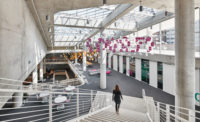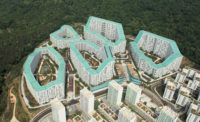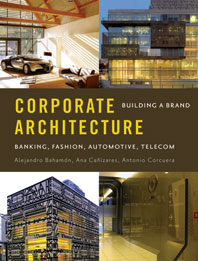In an episode of the television show Portlandia, a sketch comedy that lovingly skewers the lifestyle quirks of the young and creative, a woman (played by indie rock star Carrie Brownstein) arrives on her first day at the Portland, Oregon, offices of advertising powerhouse Wieden+Kennedy. Her new boss (Saturday Night Live cast member Fred Armisen) calls to her from a balcony inside the former warehouse building renovated by Allied Works Architecture in 2000, asking her to join him in the “basket” for an important meeting. Struggling to follow him through a wood-and-concrete maze of stairs and catwalks leading up through the office's atrium, she stumbles through a birthday party and a basketball court, gets pelted with a Frisbee and several brightly colored exercise balls, and is besieged by colleagues urging her to engage in distractions from air guitar to “mood showering.” When she finally arrives at the top floor—where she finds a meeting area set in a human-sized bird's nest—her boss asks if she was delayed because she was “having too much fun.”
The sketch satirizes both the life of the creative worker, in which selling an affect requires tearing down boundaries between work and play, and its backdrop, an increasingly common design vocabulary that fosters that confusion. While contemporary workers may regularly watch Mad Men episodes, in which professionals of another era wear dresses and flannel suits to Miesian glass towers, they are likely to be viewing them while wearing hooded sweatshirts at offices that owe more to playgrounds and dorm rooms than boardrooms.
On the playground end of the spectrum, bright pop colors and twee graphics have brought a kindergarten feel to office interiors. They often come along with oversized furnishings, beanbag chairs, the aforementioned exercise balls, or the occasional slide—a standard in Google's offices. Rows of bleachers (Wieden+Kennedy was among the first to incorporate them) have replaced auditoriums, and they otherwise function, like the steps of a school building, as vertical circulation and places to socialize. On the dorm side, office spaces come with mismatched residential furniture, rec-room finishes, street art, bicycles, skateboards, and rooms dedicated to video games.
These play-focused moves aspire to spare office workers from the crushing monotony of the cubicle, inspire creativity,and project a youthful brand: This is not your father's office, says the lime-green wall above the espresso machine to both employee and client. But they can also become cloying clichés, lazy signifiers of hipness. Whichever the case, they signal a changing approach to work culture taking hold in professions of all kinds.
To a degree, the mix of work and play reflects a contemporary trend toward extended adolescence—a frequent target of Portlandia's satire—but it has its origins in the first dotcom boom in the late 1990s, when software engineers famously brought in Ping-Pong tables to take the edge off 24/7 coding sessions. That many of these companies were founded by mostly male entrepreneurs barely in their 20s goes a long way toward explaining the juvenilia of the aesthetic. Since then, the tech industry has offered more and more amenities to attract coveted engineers. In a high-profile example, Gensler recently turned a bland corporate facility in Menlo Park, California, into a bustling campus for Facebook. (The company recently announced that Frank Gehry will design an addition to the facility.) Envisioned as a small city, the complex has storefronts to house outside businesses, including a popular local coffee chain. Employees receive free catered meals. They ride bicycles or RipStiks (skateboard-like devices) between buildings. And they can take breaks to do everything from playing video games to working in a wood shop.
A variety of flexible workspaces and the opportunity to mix nonwork activities into office life has been shown in many studies to boost creativity, productivity, and employee satisfaction, but it also lends itself to longer hours with less of a separation between work and life outside of the office. An extreme example, the contemporary tech office is a top-to-bottom Gesamtkunstwerk, merging corporate mission and branding with employee lifestyle. At its brightly colored offices, Google will wash your clothes while you work, play, or rest in a nap pod. But the amenities come with an expectation of an entrepreneurial fervor. The ideal employee at most tech firms possesses a geek's capacity for all-nighters fueled by free food and supported by comforts built into the office plan that take on the role of nanny. This works well if you're a borderline-antisocial single male in your 20s, but the infantilizing aesthetic of corporate day care patronizes workers who don't fit the boy-genius archetype and reinforces hours that can be downright hostile to those with children of their own. It also belittles creativity as childish.
In many fields—architecture not least among them—young professionals have long staked their identities and their “free” time on creating that world-changing app, spot-on ad campaign, or other professional benchmark above and beyond a paycheck, and mobile devices have made an unending workday a fact of life for everyone, but the play aesthetic has codified it into the physical workplace. And in the last decade, the style has migrated from tech and media firms to real-estate developers, banks, oil companies, and, yes, design studios. So many companies have introduced beanbags, bleachers, or other tokens of the fun office that these gestures, which once seemed surprising, have been repeated to the point of becoming banal, sometimes laughably awkward clichés. But even in their watered-down versions, these design elements signify a culture in which work and fun—along with their social and identity-forming dimensions—occur around the single valence of the office. The danger is that even if the corporate kindergarten falls out of fashion, the colonization of workers' time that it reflects will remain.









Post a comment to this article
Report Abusive Comment